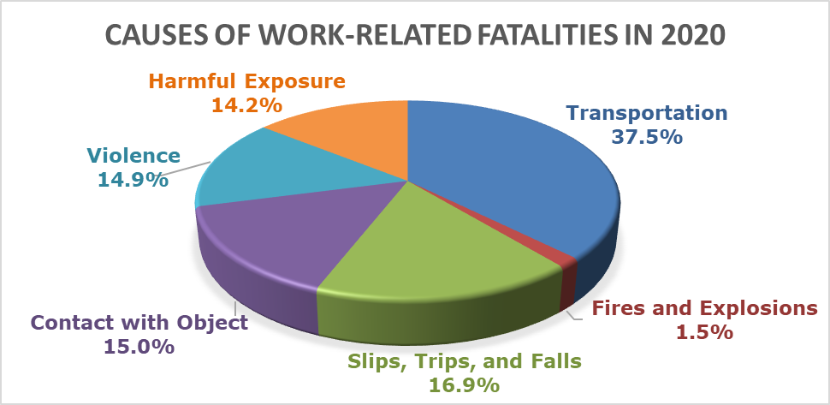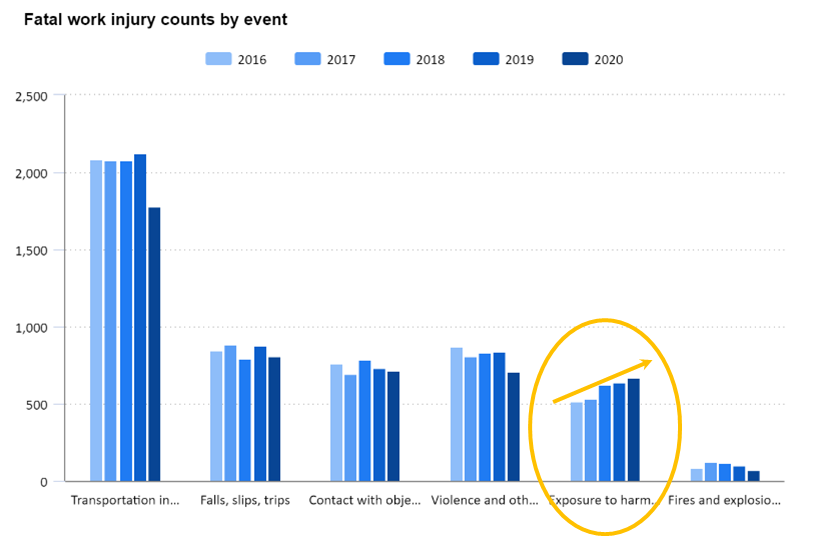“Maybe this virus has a silver lining.” — Katherine Plumhoff
The Bureau of Labor Statistics releases its workplace safety statistics for the previous year each December. The injury, illness, and fatality statistics for 2020 – The Year of Covid – just came out. The total number of work-related fatalities in 2020 fell to 4,764, over 10% less than it has been for the last several years.
I wish that was good news.
In 2020, there were almost 500 fewer work-related fatalities than the average for the previous four years. But in 2020, 377,883 people in the United States died from Covid-19.
The work-related fatality rate, at 3.4 per 100,000 full-time equivalents, stayed flat, in the 3.5±0.2 band where it has been stuck since 2009. Fewer people died on the job in 2020 than in previous years but it was because fewer people were working in 2020, not because our workplaces were safer.
Some Bright Spots
There is some good news in the BLS figures. Work-related fatalities involving transportation were down, both in absolute numbers (to be expected) and as percentage of the total. Even though the fatalities associated with commuting is not considered “work-related”, working from home apparently had a good impact on the number of transportation fatalities that were considered “work-related”, down from 40% of all fatalities to 37% of all fatalities, a statistically significant decrease.
Another bright spot was a decrease in the number of work-related homicides. While workplace violence is often the leading cause of work-related fatalities after transportation, it slipped to fourth (of six types of causes) overall, after transportation, after slips, trips, and falls, after contact with object. While homicide rates in general are up, and despite the anecdotal reporting of increased violence in the workplace as customers reacted viciously against mask mandates, overall, there was a statistically significant decrease in the violence done to workers during 2020.
A Bright Spot for Process Safety
Finally, of particular interest to those interested in process safety, there was a statistically significant decrease in the number of work-related fatalities due to fires and explosions. In most years, fires and explosions account for 2~4% of work-related fatalities. The total was down to 71 fatalities, accounting for 1.5% of the total. Twelve of those fatalities were due to vapor or dust cloud explosions; 21 were due to pressure vessel explosions. There were 31 work-related fatalities due to fires.

Data from the Bureau of Labor Statistics
What Got Worse?
Transportation, workplace violence, and fires and explosions all decreased as a percentage of the causes of work-related fatalities.
Something had to get worse.
Unfortunately for those of us concerned with process safety, it was in the category of exposure to harmful substances or environments, which was up to 14% of all causes of work-related fatalities. A few years ago, it was common to see exposure to harmful substances or environments as the cause of 7~10% of all work-related fatalities. However, it has been in a steady climb for the last 5 years, and it doesn’t appear to have anything to do with Covid-19.

Data from the Bureau of Labor Statistics
To be clear, exposure to harmful substances and environments included fatalities from heat extremes, from drowning, and from electrocution. But two thirds of all work-related fatalities in this category are from exposure to harmful substances, and it appears to be getting worse.
We in the field of process safety have our work to do.
The Deadliest Jobs
The six deadliest jobs in the U.S. are the same jobs that were the deadliest before the pandemic. Commercial fishing is still the deadliest, followed, as it usually is, by logging. The next four deadliest occupations are roofer, construction helper, aircraft pilot or flight engineers, and trash collector.
America’s Deadliest Jobs in 2020
Commercial fishing 132 fatalities per 100,000 FTEs
Logging 92 fatalities per 100,000 FTEs
Roofers 47 fatalities per 100,000 FTEs
Construction helpers 43 fatalities per 100,000 FTEs
Pilots/flight engineers 34 fatalities per 100,000 FTEs
Trash collectors 33 fatalities per 100,000 FTEs
The biggest change in this list is the decrease in the fatality rate for pilots and flight engineers, which fell from 62 fatalities per 100,000 FTEs to 34, dropping by almost half.
The Safest Jobs
The safest occupations in the U.S. are still mathematician and librarian. The fatality rates, though, were lower: down from 0.3 fatalities per 100,000 FTEs for each in 2019, which was typical, to 0.1 fatalities per 100,000 FTEs and 0.2 fatalities per 100,000 FTEs, respectively. Since transportation is leading cause of fatalities in these occupations, it should come as no surprise that the rate was down. Sadly, it will probably go back up when things return to “normal”.
Engineering, while not the safest occupation, was safer than average at a fatality rate 1.0 fatalities per 100,000 FTEs. This is lower than the year before the pandemic, when the fatality rate was 1.3 fatalities per 100,000 FTEs. The fatality rate for chemical manufacturing was also lower in 2020, at a rate of 0.9 fatalities per 100,000 FTEs.
What Next?
It will be interesting to see what happens as the vigilance over Covid-19 and its variants wanes. Will things go back to the way they were before the pandemic, or will we seize on what we have learned and make permanent changes to “normal”. Regardless of the pandemic, however, the data from the Bureau of Labor Statistics points out the need for all of us in the chemical enterprise to double down on our efforts to prevent exposures to harmful substances. Let’s get back to work.
